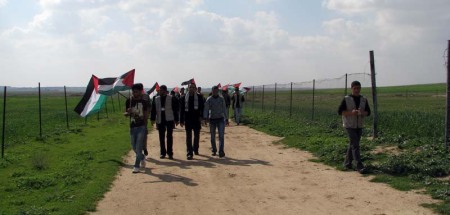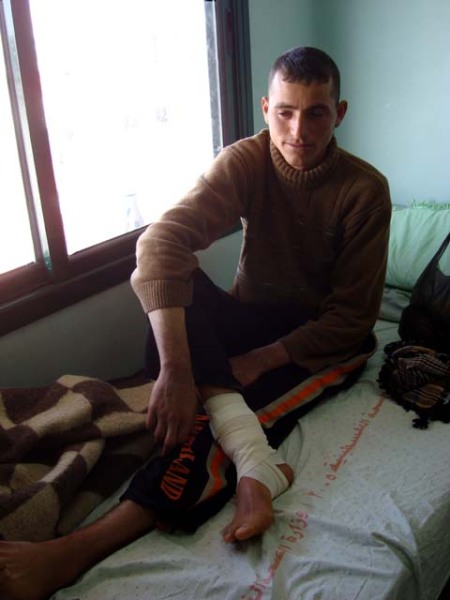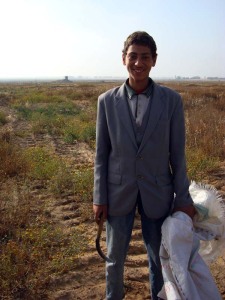Local Initiative has been leading demonstrations in the Israeli-imposed “buffer zone” –[a 300 m stretch of land flanking Gaza's border with Israel from north to south, but in reality extending up to 2 km in some area. Israeli authorities say anyone within 300 m of the border fence risk being shot.]
In the tradition of Bil’in and Ni’lin, in the occupied West Bank, Palestinian and international protesters march non-violently on Palestinian land, in protest of Israel’s unilateral annexation of this land.
Last Monday’s demonstration saw us reach roughly 50m near the border fence. Standing on their land, Beit Hanoun demonstrators said this was the first time in roughly 10 years that they had been back on the land. Ten years of an illegally-imposed ban on working and living on their land.
We join the demonstrations, as in the occupied West Bank, to protest Israel’s annexation of Palestinian land. And in the Gaza border regions, we protest the Israeli shooting, injuring and killing of Palestinian civilians living and working on land in or near the border region (and even up to 2 km away from the border).
*photo: Rada Daniell
*photo: Rada Daniell
*After Israeli soldiers begin shooting, we explain that we are clearly and visibly unarmed civilians on Palestinian land, posing no threat to the heavily-armed, fortressed soldiers.
*photo: Rada Daniell
*marching to land east of Beit Hanoun. The trees which once flourished in the region have long since been bulldozed. The majority of the water wells and cisterns in the area were destroyed over the years by Israeli bulldozers and finished-off in the Israeli war on Gaza 2008-2009.
*photo: Rada Daniell
*photo: Rada Daniell
*photo: Rada Daniell
*photo: Rada Daniell
*site of a destroyed water well, east of Beit Hanoun.
*demonstrators break to pray on their land.
*utterly devoid of the trees and life which once flourished on this fertile land east of Beit Hanoun.
*photo: Rada Daniell
Laetaemat, east of Khan Younis: across treeless fields, beyond the Israeli military jeeps and border fence, life flourishes on 1948 land, where irrigation equipment, water, crop dusters and tractors are all available and functioning. In Israel there is no ban on irrigation piping, on cement, on fertilizers, on seeds…
*destroyed agricultural land, Wadi Salqa, eastern central Gaza.
*Wadi Salqa: once smooth farmland turned topsy-turvy by Israeli bulldozers. It is impossible for farmers to reflatten the land now. the bulldozers and equipment needed to return the land to a workable state are not able to reach the area, the danger from Israeli soldiers along the border too great.
*Said Tarrabin’s daughter: Manwa Tarrabin, Said’s mother, lived in a home near the Israeli-imposed buffer zone, east of Beit Hanoun. Her house and all her possessions were destroyed the day before Israel decided to stop its massacre of Gaza.
“They told me our house was now in a closed military zone,” Manwas said. “They said it was a ‘decision from the top’ and that we had to leave immediately and walk towards Gaza,” she said. “I refused, and tried to negotiate with them for time to gather our belongings. They refused.”
Manwa was a safe distance away, watching, when the Israeli soldiers bulldozed her house at 5 pm that day.
Manwa, her daughter, Said and his family now lived in a rented home in Beit Hanoun. They are farmers and lived on their land under Israeli bulldozers destroyed their lives.
*Ghazi Zaneen, 14, shot in the head by Israeli soldiers from the border fence. Killed 4 September 2009.
Ghazi had been with his family on land reportedly 500 m from the border fence to collect figs. His mother said Ghazi had stood on some rubble to see further when Israeli soldiers targeted him.
“How would mothers in your country feel if their sons were killed like this? Don’t your politicians care that Israel is killing our children?”
*Wafa al Najar, shot by an Israeli soldier in the kneecap while on her family land east of Khan Younis.
“She was standing in the wheat field near her demolished home, about 800 m from Green Line border, when Israeli soldiers began shooting. The first two bullets hit the ground near her. The third hit her in the kneecap,” said Amal, Wafa’s mother.
“We’d gone to see our house. It was demolished during the war. We’d hadn’t been close to it yet, we thought today was safe.” her mother explained. A neighbour agreed that it seemed safe, quiet. “I was in the area before Wafa was shot. It was calm, there was nothing going on, no reason for Israeli soldiers to shoot.”
*Mohammed Al Ibrim, 20, shot 17 February by an Israeli soldier along the border fence.
“On February 17 2009, I was working with other farm-labourers on land about 500m from the border. We’d been working for a couple of hours without problems. The Israelis began shooting from the border as we pushed our pickup truck which had broken down. I was shot in the ankle. There was nothing happening, I don’t know why the Israelis shot at us.“
*Mahmoud and Mohammed, sons of martyred Anwar Al Ibrim, killed while working on land over 500m from border on 27 January by an Israeli soldier along the border fence.
*children who accompany their parents to farmland east of Khan Younis. The tradition of a family working on their land together is rendered dangerous or impossible by the presence of heavily-armed Israeli soldiers at the border.
*photo: Rada Daniell
bless his soul: Gaza Ramadan day 16
rising casualties in the buffer zone
Farmer, 4th Farmer Shot in 3 weeks
Rotting in the “Buffer Zone” or “The Shalom of Israel” [VIDEO]
Recovering dead body under Israeli fire (version with effects) [VIDEO]
farmers under fire [VIDEO]
the third hit her in the kneecap
http://ingaza.wordpress.com/2010/02/12/reclaiming-gazas-land/
























![[9_10_s22.jpg]](https://blogger.googleusercontent.com/img/b/R29vZ2xl/AVvXsEjTXnQay9wzz0E6nVHrVhaHKoq_zYXDqZjijHlNDQzj90MZzInrCuVX4ciFYCiBfZ7lhlgr2bBhhnl7ddWbhdih5JbXjQYbA605TNyiq046bQqjG2A4S-nHTmh1VBTQSG6tmc23wq47QQ/s1600/9_10_s22.jpg)




No comments:
Post a Comment